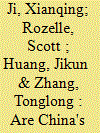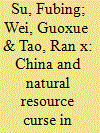|
|
|
Sort Order |
|
|
|
Items / Page
|
|
|
|
|
|
|
| Srl | Item |
| 1 |
ID:
144852


|
|
|
|
|
| Summary/Abstract |
China's agricultural sector faces challenges because most farms are still small scale. China's policy is to encourage the consolidation of farms and promote farms that are larger in scale. A question that arises is: Are China's farms growing? The goal of the present paper is to determine whether large farms in China have emerged or if farms remain small. To meet this goal, we systematically document the trends in the operational sizes of China's farms and measure the determinants of changes in farm size. Using a nationally representative dataset, the study shows that in 2013 China's farming sector was still mostly characterized by small-scale farms. However, at the same time, there is an emerging class of middle-sized and larger-sized farms. Most large farms are being run by households but there is a set of large farms that are company/cooperative-run. Today, farmers on larger farms are younger and better educated than the average farmer.
|
|
|
|
|
|
|
|
|
|
|
|
|
|
|
|
| 2 |
ID:
144851


|
|
|
|
|
| Summary/Abstract |
China's rising demand for natural resources and its growing presence in many poor and resource-rich countries have been criticized for promoting neo-colonialism in the 21st century. Using panel data for 135 developing countries from 1995 to 2007, the present paper empirically evaluates the validity of such claims. Our findings do not support the resource curse thesis in the areas of industrialization and economic growth. Moreover, the effect of resources is conditional on the initial quality of political institutions in a country.
|
|
|
|
|
|
|
|
|
|
|
|
|
|
|
|
| 3 |
ID:
144850


|
|
|
|
|
| Summary/Abstract |
Since the global financial crisis broke out in 2008, China's nonfinancial corporate debt has been rising steadily and rapidly, posing serious threat to China's financial stability. China's rising corporate debt is mainly attributable to three factors: worsening capital efficiency, worsening corporate profitability and high funding costs. Based on a dynamic recursive model developed in the paper, we simulate the trajectories of China's corporate debt-to-GDP ratio, and find that if China fails to reverse the current trends in capital efficiency, corporate profitability and financing costs, China's nonfinancial corporate debt-to-GDP ratio will continue to rise without converging to a limit. Against most economists' intuition, given the current trends of changes in parameters, higher economic growth will not help China to escape the corporate debt trap. On the contrary, it will make China's corporate debt problem even worse. To avert a corporate debt crisis, China needs to speed up the structural reform and change the growth paradigm so as to enhance capital efficiency and firms' profitability, while reducing firms' financing costs.
|
|
|
|
|
|
|
|
|
|
|
|
|
|
|
|
| 4 |
ID:
144854


|
|
|
|
|
| Summary/Abstract |
In this paper we discuss the extent to which countries in the former Silk Road regions are either reaching or failing to reach their trading potential with China. We estimate a gravity model of trade using a Poisson pseudo-maximum likelihood estimator, and estimate trade potential using in-sample, out-of-sample and counterfactual approaches. We compare trade potential using these three methods for Silk Road country trades with China. Next, we compare the estimated trade potential to actual trade, and find that most Silk Road countries are underperforming in their trade with China. However, trade performance against potential improved for most countries over the years 1990–2013. Our results suggest that China's former Silk Road trading partners have yet to realize the full potential benefits of China's economic growth but that the gap may be narrowing.
|
|
|
|
|
|
|
|
|
|
|
|
|
|
|
|
| 5 |
ID:
144855


|
|
|
|
|
| Summary/Abstract |
In 2014, the amount of RMB cross-border settlement had reached RMB7.6tn. It is important to evaluate the potential influence of RMB internationalization on China's macroeconomy. In the present study, a framework that includes monetary supply and demand was created to analyze the influences of RMB cross-border settlement on China's domestic interest rate, asset price and foreign exchange reserves. It is found that RMB settlement in different BOP items leads to very different effects on China's real economy and the financial market. Based on the analysis, we provide a framework of the policy priorities for RMB internationalization, with the RMB cross-border settlement items divided into three groups with different priorities. Meanwhile, to support RMB internationalization, exchange rate reforms should be adopted as a priority and a prudent attitude maintained regarding capital account liberalization.
|
|
|
|
|
|
|
|
|
|
|
|
|
|
|
|
| 6 |
ID:
144853


|
|
|
|
|
| Summary/Abstract |
A current concern for China's long-term growth prospect is whether China can become an innovative economy and achieve industrial upgrading to compensate for the gradually declining competitiveness resulting from low-cost labor. The present study examines this issue by exploring how trade participation impacts on the R&D investment of manufacturing firms through various channels. Merging China's Annual Manufacturing Survey Dataset and the Chinese Customs Dataset allows us to study such a relationship at the individual firm level. The empirical results suggest that channels such as geographical diversification of export markets, share of imports from high-income countries, average unit value of imports, number of intermediate goods and capital goods imports, and the trade regime are significant factors that influence firm-level R&D investment. The study discusses the policy implications of the empirical findings in relation to industrial and trade policies that may be potentially beneficial for China's transition towards an innovative economy.
|
|
|
|
|
|
|
|
|
|
|
|
|
|
|
|
|
|
|
|
|